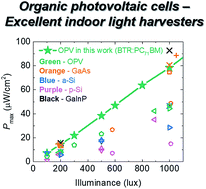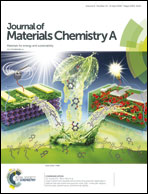Organic photovoltaic cells – promising indoor light harvesters for self-sustainable electronics†
Abstract
Photovoltaic cells are attracting significant interest for harvesting indoor light for low power consumption wireless electronics such as those required for smart homes and offices, and the rapidly-growing Internet of Things. Here, we explore the potential of solution processable, small molecule photovoltaic cells as indoor power sources. By optimizing the solvent vapour annealing (SVA) time for the photovoltaic layer, a balance between its crystallization and phase separation is obtained, resulting in a record power conversion efficiency (PCE) of over 28% under fluorescent lamps of 1000 lux, generating a maximum power density of 78.2 μW cm−2 (>10% PCE under AM1.5G). This high indoor performance surpasses that of silicon based photovoltaic cells, and is similar to that of gallium arsenide photovoltaic cells. Besides, the ratios of the voltage at the maximum power point (MPP) to the open circuit voltage are similar from indoor lighting to one sun conditions, which is unique and allows a less power consuming method to track the MPP for a broad range of light intensities (potentially attractive for wearable photovoltaics). New insight into the effect of SVA on the indoor and one sun performance is provided using advanced optoelectronic characterization techniques, which show that the mobility-lifetime products as a function of charge carrier density can be correlated well with the performance at different light levels. Our results suggest that organic photovoltaic cells could be promising as indoor power sources for self-sustainable electronics.



 Please wait while we load your content...
Please wait while we load your content...